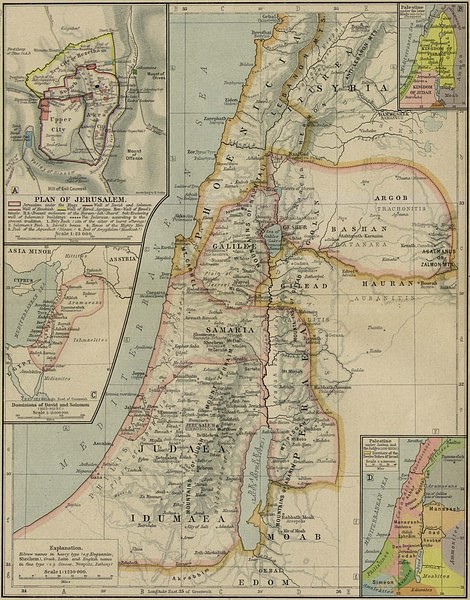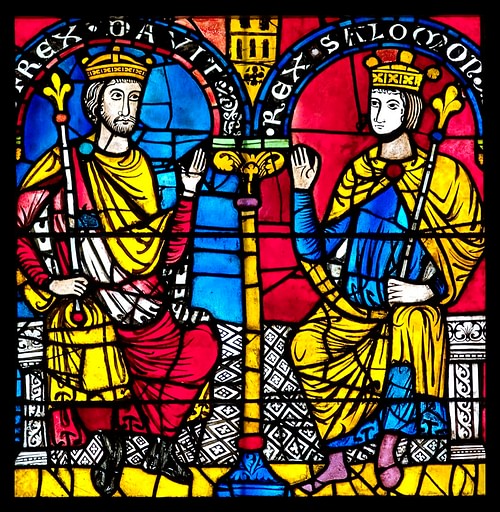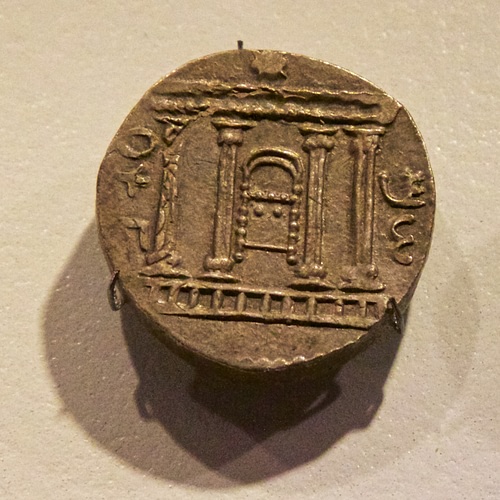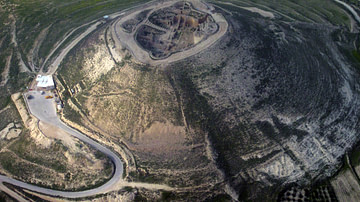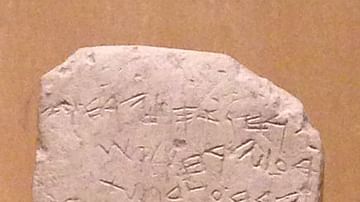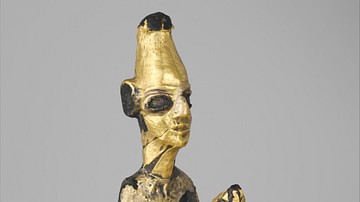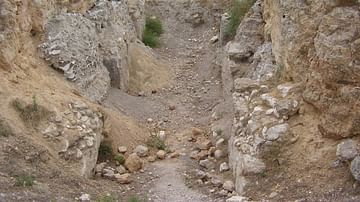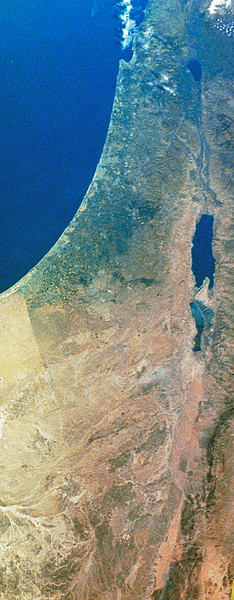
Palestine in the ancient world was part of the region known as Canaan where the Kingdoms of Israel and Judah were located. The term `Palestine' was originally a designation of an area of land in southern Canaan which the people known as the Philistines occupied a very small part of.
The Canaanites, Canaanite-Phoenicians, and the Israelites, among others, established themselves in the area much earlier. The Philistines are thought to have come to the area toward the end of the Bronze Age c. 1276 BCE and established themselves on the southern coastal plain of the Mediterranean Sea in an area afterwards known as Philistia.
The whole of the region was referred to as `Canaan' in Mesopotamian texts and trade records found at Ebla and Mari as early as the 18th century BCE while the term `Palestine' does not appear in any written records until the 5th century BCE in the Histories of Herodotus. After Herodotus, the term `Palestine' came to be used for the entire region which was formerly known as Canaan.
The region is part of the so-called fertile crescent and human habitation there can be traced back to before 10, 000 BCE. The lands were originally inhabited by nomadic hunter-gatherers who most likely immigrated from Mesopotamia but became sedentary agriculturalists by the Early Bronze Age (c.3300-c.2000 BCE). In the Middle Bronze Age (c. 2000-c.1550 BCE)) trade with other nations expanded and Canaan prospered and in the Late Bronze Age (c.1550-c. 1200 BCE) this affluence continued as the region was incorporated into the Egyptian Empire (c.1570-c.1069 BCE).
As Egypt's influence and power waned, that of the Assyrians grew and there were Assyrian incursions into other lands as early as 1295 BCE. The entire Near East suffered during the so-called Bronze Age Collapse of c. 1250-c. 1150 BCE and Canaan was no exception. According to the biblical Book of Joshua, the Israelite general Joshua invaded the land and divided the region among his people. At approximately the same time, however, the Sea Peoples (whose identity remains unknown) arrived in the region and could have been responsible for the evident destruction of towns and cities, as they were in other nations.
The Assyrians, Babylonians, Persians, and the armies of Alexander the Great all conquered the region in succession and, finally, so too, the armies of Rome. By the time Rome appeared in the land it was long known as Judea, a term taken from the ancient Kingdom of Judah which had been destroyed by the Babylonians. It was also referred to, however, as Palestine and, after the Bar-Kochba Revolt of 132-136 CE, the Roman emperor Hadrian renamed the region Syria-Palaestina to punish the Jewish people for their insurrection (by naming it after their two traditional enemies, the Syrians and the Philistines). The designations Philistia, Roman Judea, and Palestine were all in use afterwards.
When the Western Roman Empire fell, Palestine was taken by the Eastern or Byzantine Empire and held until c. 634 CE when it was taken by invading Muslim armies from Arabia.
Name
The name `Palestine' is thought to derive from either the word plesheth (meaning `root palash', an edible concoction carried by migratory tribes which came to symbolize nomadic peoples) or as a Greek designation for the nomadic Philistines. The author Tom Robbins has suggested the term `Palestine' originates from the ancient androgynous god Pales who was worshipped in the region of Canaan. If this is so then `Palestine' means `Land of Pales'.
It has been established that there was an androgynous deity named Pales (referred to in texts as both a god and a goddess) who was recognized by the Romans as the patron deity of shepherds and sheep and whose festivals were celebrated on 21 April and 7 July in Rome in the area of the Palatine Hill (Adkins & Adkins, 269). There is, however, no documentation from ancient times linking this deity to the name of the region of Palestine and, most likely, the name derives from the Greek for `the Land of the Philistines'. Scholars J Maxwell Miller and John H. Hayes support this conclusion, writing:
Along the southern coastal plain of the Eastern Mediterranean seaboard (roughly south of present-day Tel Aviv) were settled the Philistines. They came to that region as a part of the general `Sea Peoples' migrations at the end of the Bronze Age and inhabited five main cities – Ashdod, Ashkelon, Ekron, Gath, and Gaza. Although historically the Philistines are to be associated specifically with the coastal plain, during Classical Times the name `Philistia' (“Land of the Philistines”) came to be applied more generally to the whole southern end of the Eastern Mediterranean Seaboard…In short, then, the English term `Palestine' derives ultimately from `Philistia'. (39-40)
Following Herodotus' use of the term in his work in the 5th century BCE, other writers adopted it in their own and `Palestine' gradually replaced `Canaan' as the name of the region.
Early History
The region of Palestine is among the earliest sites of human habitation in the world. Archaeological evidence suggests a hunter-gatherer community living a nomadic existence in the region pre-10,000 BCE. In the Early Bronze Age, permanent settlements were founded and agricultural communities developed. Trade was initiated with other regions in the Near East and, because of its location between the cities of Mesopotamia and those of Arabia and Egypt, Palestine became an important trading hub and attracted the attention of Sargon the Great (r. 2334-2279 BCE) who absorbed the region into his Akkadian Empire c. 2300 BCE.
The affluence of the Akkadian Empire at this time encouraged the growth of urban centers throughout the region and Palestine flourished until Akkad fell to the invading armies of the Gutians, Elamites, and Amorites in c. 2083 BCE. After this, the cities were abandoned and the people returned to a rural, agrarian lifestyle, possibly due to overpopulation, though the reasons are unclear.
Middle Bronze Age
In the Middle Bronze Age (c. 2000-c.1550 BCE), the people again embraced urbanization and trade flourished. International commerce had first been established between the port city of Byblos and Egypt in c. 4000 BCE and, by 2000 BCE, Egypt was the region's most influential partner in trade. Egypt's influence is evident in the pattern of burial rituals in the region which closely mirror Egypt's in terms of the type of grave goods included in the tombs.
This partnership continued to benefit both Egypt and the Palestine region until the arrival of the Semitic peoples known as the Hyksos in c. 1725 BCE. The Hyksos, known in ancient Egyptian inscriptions only as “foreign kings”, were able to use Palestine to gain a foothold in the Delta region of Lower Egypt toward the end of Egypt's Middle Kingdom (2040-1782 BCE) and establish themselves as a political entity at Avaris.
In time, they became powerful enough to initiate trade, muster armies, and take control of the Delta and a large part of Lower Egypt until they were driven out by Ahmose I of Thebes in 1570 BCE. Ahmose I's campaign pursued the Hyksos north through Palestine into Syria, leaving ruined cities and scattered communities in his wake.
Late Bronze Age
Following the expulsion of the Hyksos, the cities of Palestine were rebuilt and Ahmose I absorbed the region into the newly formed Egyptian Empire (also referred to as the New Kingdom, c. 1570-c.1069 BCE). Ahmose I wanted to make sure that no other foreign power would infiltrate Egypt's border and so created a buffer-zone around Egypt's borders which was enlarged by later pharaohs to form their empire.
Some of the most famous Egyptian pharaohs ruled during the New Kingdom and patronized Palestine in trade and through building projects. Hatshepsut (r. 1479-1458 BCE), Thutmose III (r. 1458-1425 BCE), Amenhotep III (r. 1386-1353 BCE), and Ramesses the Great (r. 1279-1213 BCE), among many others, encouraged trade in the region and improved its infrastructure.
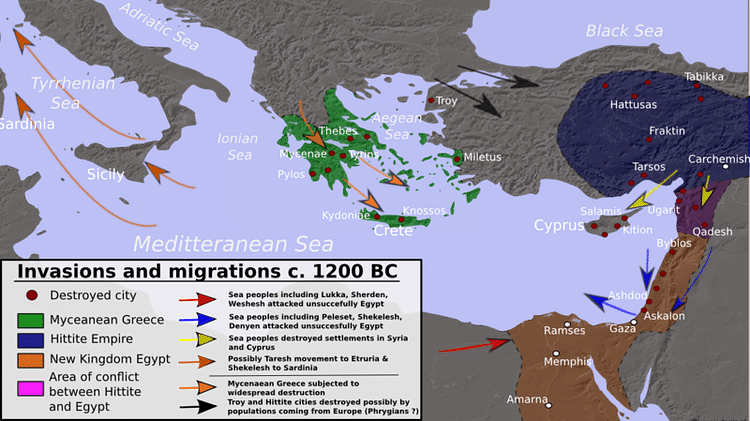
During the reign of Thutmose III, a people known as the Habiru disturbed the peace through raids on communities. The identity of these people (like the Hyksos and Sea Peoples) is unknown but they appear to have been native to the region and the term `Habiru' used to designate those who refused to conform any longer to the rules of society. They are described as outlaws rather than invaders and past attempts by modern-day scholars to link the Habiru with the Hebrews have been discredited.
During the reign of Ramesses the Great, the Sea Peoples make their first appearance in Egypt's history. Ramesses defeated them in a sea battle off his coast in c. 1278 BCE and again encountered them in 1274 BCE as allies of the Hittites at the Battle of Kadesh. Who they were and where they came from is still debated in the present day but they returned to wage war on Egypt during the reign of Merenptah (r. 1213-1203 BCE) and later during the reign of Ramesses III (r. 1186-1155 BCE). At the same time they were harassing Egypt, the Sea Peoples were also wreaking havoc on the Hittite Empire and throughout the Levant. Their activities, along with Assyrian incursions beginning c. 1300 BCE, threw the region of the Near East into chaos.
It is about this same time, c. 1250-1200 BCE, that the conquest of Canaan by the Israelite general Joshua is thought to have occurred as related in the biblical Book of Joshua and, to a lesser extent, in the Book of Numbers. While there is certainly evidence of a great upheaval in the land at this time, the archaeological evidence does not fit with the biblical narrative and it is possible the land was overrun by the Sea Peoples.
The first mention of Israel comes from the stele of Merenptah who claims that “Israel is devastated” in the description of his victory over the Libyans (who were allies of the Sea Peoples). The stele seems to be referring to `Israel' as a people, not as a kingdom or city-state, and it is possible that the Israelites joined with the Sea Peoples and Libyans in a push against Egypt, though this is speculative.
At some point after the alleged invasion by general Joshua, however, the Israelites are firmly established in Palestine and, by c. 1080 BCE, the Kingdom of Israel is founded in the north. Israel would flourish as a united kingdom until after the death of King Solomon (c. 965-931 BCE) when it split in two as the Kingdom of Israel with its capital at Samaria in the north and the Kingdom of Judah with the capital at Jerusalem in the south. Throughout the reigns of the early Israelite kings, and later, the Philistines are repeatedly referenced in the Bible as their sworn enemies.
The Philistines & Foreign Conquerors
The Philistines (thought to be from Crete and, most likely, from the Aegean area) landed on the southern Mediterranean coast of Canaan in circa 1276 BCE after being repulsed in their invasion of Egypt (along with the Sea Peoples) by Rameses III. By 1185 BCE they had established themselves firmly in settlements along the coast known as Philistia. Other, older, settlements were already thriving in the area upon their arrival and the Philistines went quickly to work to subdue them.
According to biblical narratives, the Philistines were organized and efficient enough to cause the early Israelite tribes and cities a great deal of trouble. They posed a significant threat to the Israelite King Saul (r. c. 1080-1010 BCE), were defeated by his successor, King David (r. c. 1035-970 BCE), and were still enemies of Israel under King Solomon but, in spite of Israelite victories over them, they continued to thrive along the coast and harass their neighbors.
In 722 BCE, the region was overrun by the Assyrians and the Kingdom of Israel was destroyed. At this same time, the Philistines were subdued completely and lost their autonomy. The Neo-Assyrian Empire claimed Palestine and their king Sennacherib (r.705-681 BCE) launched a campaign in the region in 703 BCE. Although he failed to take Jerusalem, he succeeded in making Judah a vassal state.
The Assyrians held the region until the fall of their empire in 612 BCE to a coalition led by Babylonians and Medes and, shortly after, the Babylonians invaded Palestine in 598 BCE and sacked Jerusalem, destroyed the Temple of Solomon, and took the leading citizens among the Israelites back to Babylon (a period in Jewish history known as the Babylonian Captivity). They returned between 589-582 BCE and destroyed the rest of Judah, scattering the Philistines at the same time.
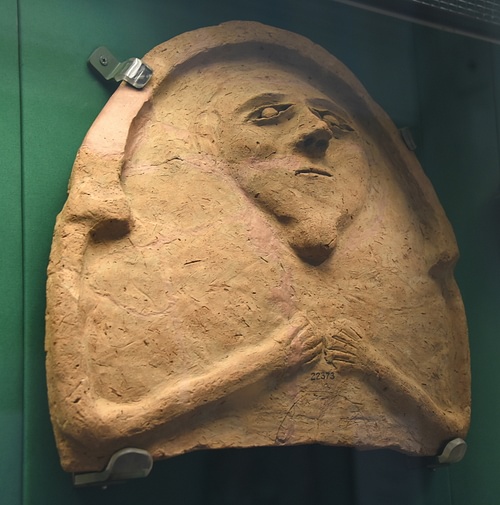
Babylon fell to Cyrus the Great (d. 530 BCE) who absorbed the region into the Achaemenid Empire and allowed the Jews to return from Babylon to their homeland. The Persian Empire fell to Alexander the Great (356-323 BCE) and, after him, the Seleucids controlled the region until c. 168 BCE when the Maccabees revolted against foreign rule and the imposition of foreign religion and established the Hasmonean Dynasty, the last independent Judean kingdom. Rome involved itself in the region's affairs in 63 BCE and, after Augustus became emperor, Palestine became a province known as Roman Judea in c. 31 BCE.
The Jewish-Roman Wars
The Romans installed a king of their choice, Herod the Great, to rule the region and imposed the same tax levies on Judea as they did other provinces in the empire. The people resented Roman rule and occupation, however, and Judea proved an especially problematic region for Rome.
The years 66-73 CE saw the First Jewish-Roman war which resulted in Titus destroying Jerusalem, including the Second Temple (leaving only the Western Wall) and leading to the martyrdom of the defenders of Masada. Although the people of the land were free, within reason, to adhere to their own cultures and religious beliefs, they were still under Roman rule and wanted their independence.
In 115-117 CE, the conflict known as the Kitos War broke out (so-named from a corruption of the name of the Roman general, Lucius Quietus, who commanded the Roman legions). This conflict also ended in a Roman victory and a relative peace was restored. In 132 CE, however, the Bar-Kochba Revolt (132-136 CE) broke out and proved the most costly to both sides (although the Judeans suffered the worse casualties with over 500,000 combatants killed, not counting many others). The Emperor Hadrian was so enraged by Jewish resistance that he re-named the province Syria Palaestina (after the two traditional enemies of the Jews, the Syrians and the Philistines) and banished all Jews from the region, building his city Aelia Capitolina on the ruins of Jerusalem. The Bar-Kochba Revolt was the last of the Jewish-Roman Wars and, afterwards, Rome held the region without further serious incident.
Conclusion
The emperor Diocletian (r.284-305 CE) divided the Roman Empire in two, the Western Empire which controlled Europe and the Eastern Empire (later known as the Byzantine Empire) which administrated affairs in the Near East and, of course, held Syria-Palaestina. When the emperor Constantine the Great (r.306-337 CE) legitimized Christianity and made it the state religion, Syria-Palaestina became a Christian province and an important center for the new faith.
The Western Roman Empire fell in 476 CE but the Byzantine Empire continued on relatively unchallenged until the 7th century CE and the rise of Islam in the region. In 634 CE, the Muslim armies from Arabia took Syria-Palaestina and renamed it Jund Filastin (“Military District of Palestine”). The Muslims felt they had as much of a religious stake in the region as the Christians or as the Jews before them and churches were turned into mosques in the same way that earlier temples had given way to churches.
Palestine came to be referred to by European Christians as the Holy Land and the First Crusade was launched to win it back from Muslim occupation in 1096 CE. This effort was followed by many more, supported by the Byzantine Empire, through 1272 CE at enormous cost of life and property but with nothing finally gained. The Byzantine Empire fell in 1453 CE, greatly reducing Christian influence in the region, and Palestine was held by the Ottoman Turks. The region continued to be contested throughout the next few centuries until the British involved themselves in 1915 CE during World War I at which time the western powers first devised plans to partition the Middle East for their own purposes and benefit.
Palestine continued to be a war-torn and much-contested region up through World War II when, afterwards, the United Nations declared the area the State of Israel and established it as a homeland for the Jewish people. This mandate by the United Nations, and the resulting country of Israel, remains controversial and the region continues to be as troubled in the present day as it was in ancient times.
